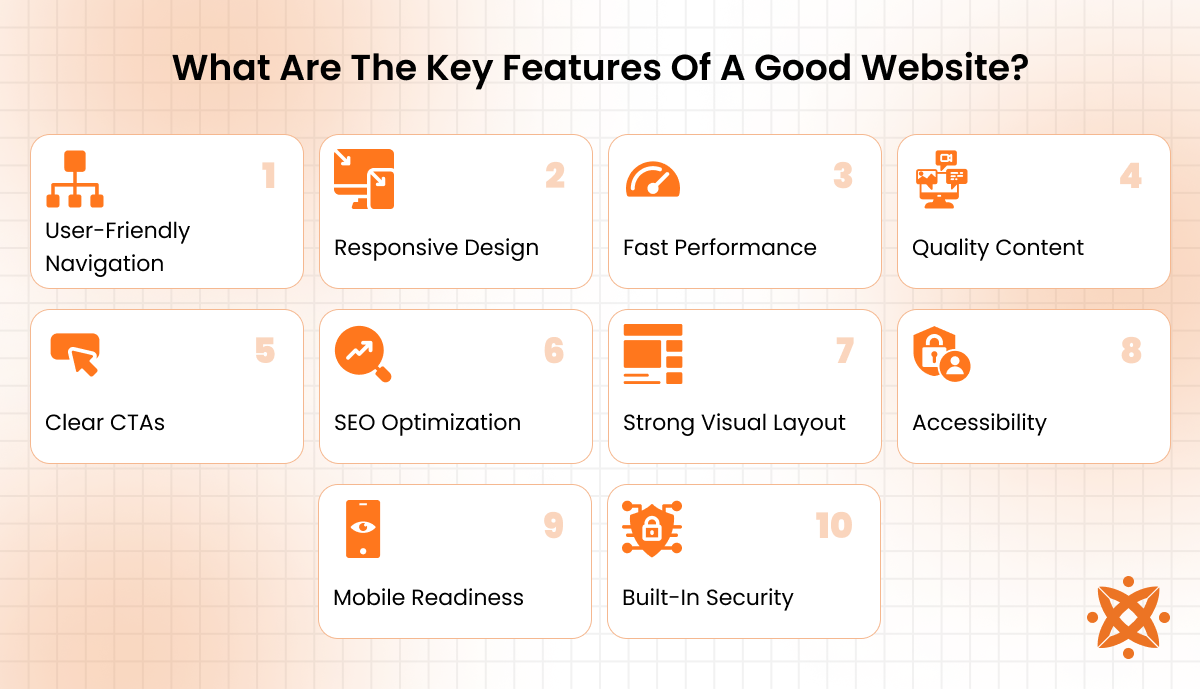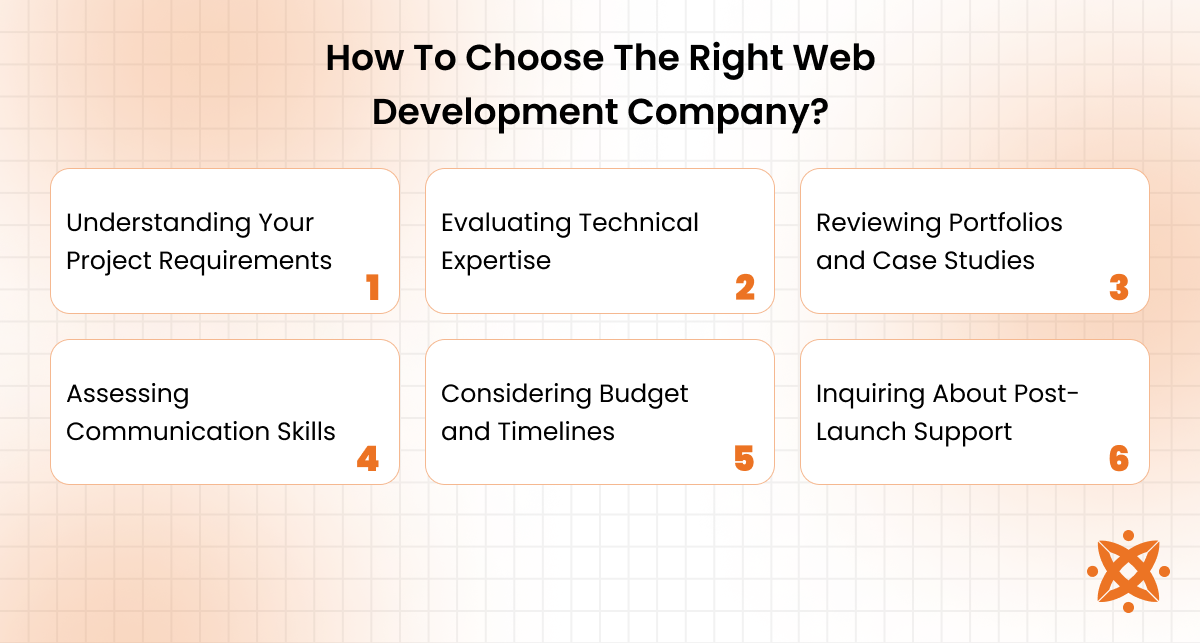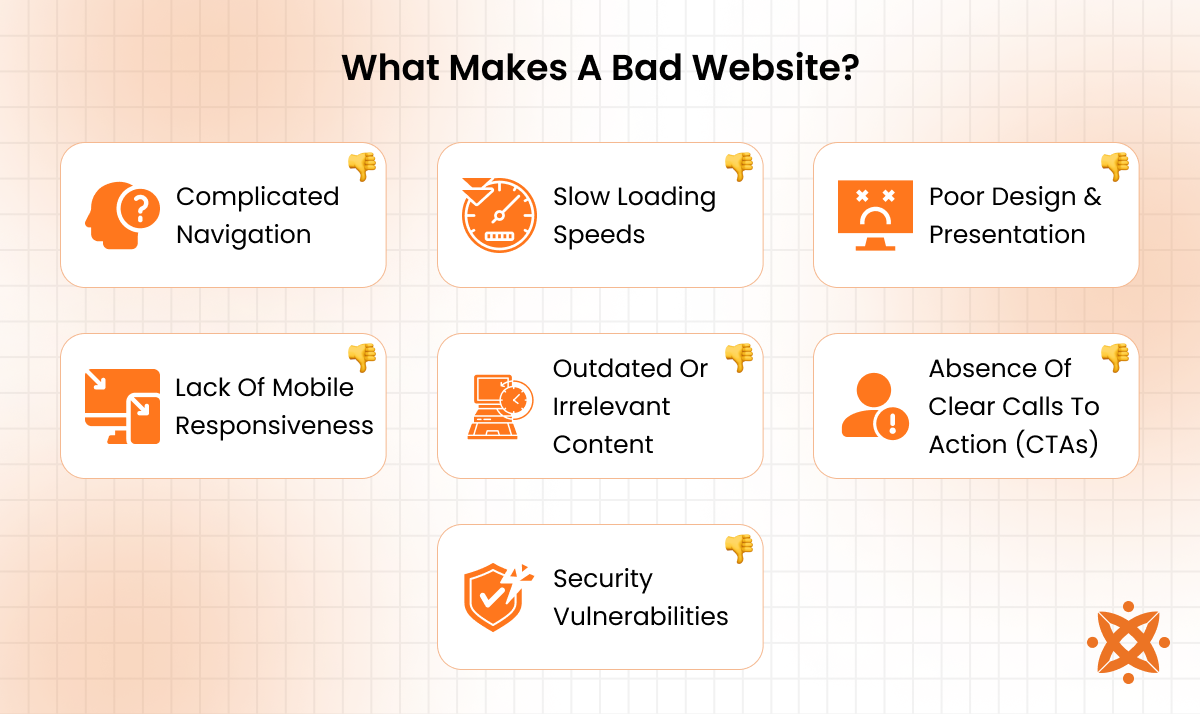A good website is user-focused, visually appealing, functionally reliable, SEO-optimized, and aligned with a clear business purpose. It effectively connects with your target audience by offering intuitive navigation, fast loading speeds, responsive design, and high-quality content tailored to user intent. When these elements work together, your website becomes a valuable tool for engagement, visibility, and conversion.
Good website design depends on ten key factors such as a user-friendly structure, responsiveness across devices, strong performance, relevant content, clear calls to action, technical SEO readiness, clean visual layout, accessibility, mobile optimization, and secure hosting with SSL. Each factor directly improves usability and search performance.
According to a study by GoodFirms titled “Web Design Statistics,” 2023, 73.1% of users leave a website due to non-responsiveness, and 85% expect the mobile version to match desktop quality.
To choose the right web development company, focus on goal alignment, technical experience, past work, clear communication, realistic timelines, and dependable maintenance. These core considerations ensure you work with a partner capable of delivering a high-performing site tailored to your objectives.
What Are The Key Features Of A Good Website?
Key features of a good website include user-friendly navigation, responsive design, fast performance, quality content, clear CTAs, SEO optimization, strong visual layout, accessibility, mobile readiness, and built-in security. These qualities ensure your site delivers a seamless experience to both users and search engines.
Key features of a good website are as follows:
User-Friendly Navigation Structure
User-friendly navigation refers to how easily you move around a website and find what you’re looking for without confusion. A good navigation system supports clarity, efficiency, and a seamless flow of information. It reduces the effort needed to explore a website, improving your overall experience and encouraging deeper engagement with the content.
According to a study by the Nielsen Norman Group titled “Effective Navigation Design,” 2023, websites with clear and consistent navigation reduce user task completion time by 30% and improve return visit rates by 50%.
The core principles of effective navigation are simplicity, consistency, clarity, and feedback. Navigation should be intuitive, using clear and familiar terms to label menu items. You benefit most when the layout remains consistent across all pages and when active pages are visually highlighted, so you always know where you are. This structure not only supports usability but also lowers bounce rates and improves time on site.
Some of the most important navigation elements include the top menu, which connects you to key areas of the site; the footer menu, where you find supporting links like privacy policies or contact details; and breadcrumbs, which track your browsing path to help you move backward easily. Sidebar links are also useful, especially for blogs or product listings, helping you discover related content without starting from scratch.
For responsive navigation, mobile-first best practices are key. Collapsible menus, often represented by a hamburger icon, help reduce clutter on smaller screens. Buttons and links must be touch-friendly to prevent accidental taps, and the layout should adjust smoothly across devices of all screen sizes. These adjustments ensure you always have a consistent and accessible experience, whether you’re on a laptop or smartphone.
Responsive Design For All Devices
Responsive web design ensures that your website adapts seamlessly to various devices and screen sizes, providing an optimal viewing experience. This approach dynamically adjusts layouts, images, and other elements to prevent issues like distortion or excessive scrolling, enhancing usability across desktops, tablets, and smartphones.
The core technical components that make a website responsive include fluid grids, flexible images, and media queries. Fluid grids use relative units like percentages rather than fixed units like pixels, allowing layout elements to resize proportionally to the screen size.
Flexible images adjust within their containing elements, preventing them from displaying outside their intended boundaries or causing layout issues. Media queries enable the application of different CSS styles based on device characteristics such as width, height, and orientation, facilitating tailored presentations for various devices.
Implementing Important responsive design patterns further enhances adaptability. The ‘Mostly Fluid’ pattern maintains a consistent layout that scales proportionally across devices, ensuring a uniform experience. The ‘Column Drop’ pattern stacks columns vertically on smaller screens to preserve readability and accessibility.
The ‘Layout Shifter’ pattern involves more complex rearrangements of content blocks to optimize space utilization and user experience on different devices. The ‘Off-Canvas’ pattern hides secondary content off-screen on smaller devices, accessible via user interaction, to maintain a clean and focused interface.
Testing your responsive web design is important to ensure consistent performance across devices. This involves manually resizing the browser window to observe layout adjustments and using developer tools in browsers like Chrome and Firefox to simulate various screen sizes and resolutions.
According to Google titled “Mobile-Friendly Websites,” published in 2023, 61% of users are unlikely to return to a site that is not optimized for mobile devices.
Website Speed And Performance Optimization
Fast loading speed refers to the time it takes for your website’s content to fully display on a user’s device after they request it. This metric is Vital, as a swift load time enhances user experience, reduces bounce rates, and improves search engine rankings.
According to a Google study titled “Page Load Time Statistics,” 2023, as page load time increases from one second to ten seconds, the probability of a mobile site visitor bouncing increases by 123%.
Several factors influence your website’s loading speed. The quality of your hosting service plays a significant role; shared hosting leads to slower response times due to resource competition among multiple websites. The complexity and efficiency of your website’s code also impact speed; excessive or poorly written HTML, CSS, and JavaScript increase load times.
Large file sizes, particularly unoptimized images and videos, add to the load time, while numerous HTTP requests from multiple page elements further slow down your site. Additionally, high traffic volumes overwhelm your server if it’s not equipped to handle the load, leading to decreased performance.
Various tools are available to measure and monitor your website’s speed. Google’s PageSpeed Insights analyzes your site’s performance on mobile and desktop devices and provides suggestions for improvement. Pingdom offers insights into load times, performance grades, and areas needing optimization.
GTmetrix combines data from Google PageSpeed Insights and Yahoo’s YSlow to deliver comprehensive performance reports. Regular use of these tools helps you identify bottlenecks and track the impact of any optimizations you implement.
High-Quality And Relevant Website Content
High-quality content refers to material that is useful, accurate, reliable, and relevant to its intended audience. It is well-researched and thoughtfully produced to provide genuine value, the exact information or solutions that readers are seeking.
Vital components of quality content include clarity, accuracy, and engagement. Clarity ensures that the information is easily understood, avoiding jargon and complex language. Accuracy means providing truthful and well-researched information, which builds trust with your audience. Engagement is the ability of the content to captivate and hold the reader’s attention, often achieved through compelling storytelling or interactive elements.
Key content optimization requirements involve aligning content with search intent, incorporating relevant keywords, and ensuring readability. Aligning content with search intent means understanding what users are looking for and tailoring your content to meet those needs. Incorporating relevant keywords helps search engines understand the topic of your content, improving its visibility.
Content maintenance standards require regular updates to keep information current and relevant. This includes reviewing and refreshing existing content to reflect the latest information and trends. Regular maintenance not only provides value to your audience but also signals to search engines that your site is active, which positively impacts rankings. citeturn0search21
According to a study by the Content Marketing Institute titled “Quality Content: How to Define What It Means,” 2023, quality content is honest, clear, and serves no hidden agendas. The audience is smart and will see right through content that pretends to be one thing but is actually a veiled attempt at generating transactions.
Clear And Actionable CTAs
A Call to Action (CTA) is a prompt designed to elicit an immediate response from your audience, guiding them toward a specific action such as subscribing to a newsletter, making a purchase, or downloading a resource. Effective CTAs are Vital in directing user behavior and enhancing engagement on your website.
The Important components of an effective CTA include clarity, compelling language, and strategic placement. Clarity ensures that the action you want users to take is unambiguous and easily understood. Compelling language involves using persuasive and action-oriented words that resonate with your audience and motivate them to act.
Strategic placement refers to positioning the CTA where it is most likely to capture attention, such as at the end of a blog post or in a prominent section of a webpage. citeturn0search5
Key design principles for CTAs encompass visibility, color contrast, and size. Visibility ensures that the CTA stands out from other elements on the page, drawing the user’s eye. Utilizing color contrast between the CTA and the background enhances its prominence. Appropriate sizing ensures that the CTA is large enough to be noticed but not so large that it overwhelms other content.
Measuring the performance of CTAs involves analyzing metrics such as Click-Through Rate (CTR), Conversion Rate, and Bounce Rate. CTR calculates the percentage of users who click on the CTA compared to the total number of users who view it, indicating its effectiveness in prompting clicks. Conversion Rate measures the percentage of users who complete the desired action after clicking the CTA, reflecting its success in driving conversions.
Bounce Rate assesses the percentage of users who leave the webpage without taking further action after interacting with the CTA, highlighting potential issues with the CTA or the landing page experience. citeturn0search15
According to a study by Unbounce titled “15 Call-To-Action Examples for 2025,” 2025, CTAs that combine strong copy with good design significantly enhance user engagement and conversion rates.
SEO Optimization
Search Engine Optimization (SEO) is the practice of enhancing your website to improve its visibility in search engine results pages (SERPs), thereby increasing the quality and quantity of organic traffic. This involves optimizing various elements of your site to align with search engine algorithms and user intent.
According to a study by the Digital Marketing Institute titled “What Is SEO And How Does It Work?” 2024, implementing effective SEO strategies significantly enhances online visibility and drives organic traffic to your website.
Vital technical SEO requirements include ensuring your site uses HTTPS for secure connections, which builds trust with users and is favored by search engines. Addressing duplicate content issues is vital, as identical content dilutes your site’s authority; implementing canonical tags helps specify the preferred version of a page.
It’s also important to have only one accessible version of your website (either with or without ‘www’) to prevent splitting traffic and link equity. Optimizing your site’s robots.txt file guides search engine crawlers on which pages to index, and submitting an XML sitemap aids in efficient content discovery and indexing. citeturn0search2
Important on-page SEO elements encompass crafting unique, helpful content that addresses user needs and strategically placing target keywords in titles, headings, and throughout the content to signal relevance to search engines. Writing compelling title tags and meta descriptions encourages higher click-through rates from SERPs.
Using headings and subheadings structures your content, making it more readable and helping search engines understand the hierarchy and main topics of your page. Optimizing URLs to be descriptive and including relevant keywords enhances clarity and relevance.
Key SEO performance tracking metrics include organic traffic, which measures the number of visitors coming to your site through unpaid search results. This metric reflects the effectiveness of your SEO efforts. Monitoring keyword rankings helps you understand your site’s visibility for specific search terms.
Tracking conversion rates indicates how well your site turns visitors into desired actions, such as purchases or sign-ups. Analyzing bounce rates reveals the percentage of visitors who leave your site after viewing only one page, highlighting potential issues with content relevance or user experience. Tools like Google Analytics and Google Search Console provide comprehensive data to monitor these metrics.
Visual Design And Layout Appeal
Visual appeal refers to the aesthetic attractiveness of a website, encompassing elements such as colors, shapes, images, fonts, white space, and overall visual balance. These components collectively influence users’ perceptions, interactions, and retention of the site.
Important visual design elements include line, shape, color, texture, space, and typography. Lines guide the user’s eye and create divisions between sections. Shapes contribute to the formation of icons and buttons, enhancing usability. Color schemes evoke emotions and establish brand identity.
Textures provide a sense of depth and realism. Effective use of space, particularly white space, improves readability and focus. Typography involves selecting appropriate fonts and text arrangements to ensure content legibility and convey the desired tone.
Key visual design principles include contrast, balance, emphasis, hierarchy, and unity. Contrast differentiates elements, making important features stand out. Balance ensures a harmonious distribution of visual weight, creating stability.
Emphasis directs attention to critical areas or actions. Hierarchy organizes content to guide users through information in a prioritized manner. Unity ensures all design elements are cohesive, providing a consistent experience.
Visual testing and optimization involve evaluating and refining a website’s visual elements to ensure consistency, responsiveness, and alignment with design standards. This process includes testing across various devices and screen sizes to maintain visual integrity and user experience.
Automated tools, such as visual regression testing frameworks, detect unintended visual changes during development. Regular user feedback and A/B testing further inform design improvements, leading to enhanced engagement and satisfaction.
According to a study by the Nielsen Norman Group titled “The Importance of Visual Design in UX,” 2020, effective visual design not only enhances aesthetic appeal but also improves usability and user satisfaction.
Accessibility Features
Web accessibility ensures that websites, tools, and technologies are designed and developed to effectively accommodate people with disabilities. This encompasses the ability to perceive, understand, navigate, and interact with the Web and contribute to it.
According to a study by the World Wide Web Consortium (W3C) titled “Web Accessibility Initiative (WAI) Overview,” 2023, implementing web accessibility benefits individuals with disabilities. It enhances the overall user experience and satisfaction for all users.
Important accessibility requirements include providing text alternatives for non-text content, ensuring that all functionalities are available from a keyboard, and making content adaptable to different presentation formats without losing information. These requirements are outlined in the Web Content Accessibility Guidelines (WCAG), which serve as a benchmark for web accessibility.
Key accessibility components to implement involve using semantic HTML to convey meaning and structure, ensuring sufficient color contrast between text and background, and providing clear and consistent navigation options. Additionally, it is important to ensure that interactive elements are accessible and usable with assistive technologies.
Accessibility testing standards involve evaluating web content against established guidelines such as WCAG. This process includes both automated testing tools and manual evaluations to identify and rectify accessibility barriers. Regular testing ensures that web content remains accessible as it evolves.
Mobile Optimization
Mobile optimization is the process of adjusting your website content to ensure visitors accessing the site from mobile devices have an experience customized to that device. According to a study by Statista titled “Global mobile traffic 2024,” 2024, mobile devices (excluding tablets) generated 62.54 percent of global website traffic in the last quarter of 2024
Important components of mobile optimization include responsive design, which allows your website to adapt seamlessly to various screen sizes and orientations, providing a consistent user experience across devices.
Page speed optimization is Vital, as mobile users expect quick load times; techniques such as compressing images and minimizing HTTP requests enhance performance. Mobile-friendly navigation ensures that menus and links are easily accessible and usable on smaller screens, often implemented through simplified menus or touch-friendly buttons.
Key mobile performance requirements encompass fast loading speeds, with users expecting pages to load within three seconds to prevent high bounce rates. Efficient resource usage is vital to conserve device battery life and data consumption, achieved by optimizing code and media files. Cross-device compatibility ensures your website functions correctly across various devices and operating systems, necessitating thorough testing on multiple platforms.
Mobile testing standards involve evaluating your website’s performance, usability, and consistency across different devices and browsers. This includes conducting functional testing to verify that all features operate as intended, performance testing to assess load times and responsiveness, and usability testing to ensure an intuitive user experience.
Website Security Features And SSL Integration
Website security encompasses the strategies and measures implemented to protect a website and its data from cyber threats, unauthorized access, and other malicious activities. Ensuring robust website security is vital for safeguarding sensitive information, maintaining user trust, and ensuring compliance with legal and regulatory standards.
According to a study by IBM titled “Cost of a Data Breach Report 2024,” 2024, the global average cost of a data breach reached $4.88 million.
Important components of website security include secure hosting, regular software updates, and the deployment of web application firewalls (WAFs). Secure hosting involves selecting a reliable web hosting provider that offers robust security features such as firewalls and intrusion detection systems, which are fundamental in defending against potential cyber threats.
Regularly updating software, including content management systems and plugins, is critical to protect against known vulnerabilities that cybercriminals might exploit. Implementing WAFs acts as a barrier between your website and incoming traffic, filtering out malicious requests and protecting against common attacks like SQL injections and cross-site scripting.
SSL/TLS, HTTPS, and SFTP are common security protocols integral to website security. SSL (Secure Sockets Layer) and its successor, TLS (Transport Layer Security), are cryptographic protocols that provide secure communication over the Internet by encrypting data transmitted between a web server and a browser.
HTTPS (Hypertext Transfer Protocol Secure) is an extension of HTTP that utilizes SSL/TLS to encrypt data transfer, ensuring secure communication and building user trust. SFTP (Secure File Transfer Protocol) offers a safe method for transferring files over the internet, encrypting both commands and data to prevent unauthorized access during transmission.
Security monitoring and maintenance involve continuous oversight to detect and respond to potential threats promptly. This includes regular security audits, vulnerability assessments, and real-time monitoring of network traffic to identify and mitigate security risks effectively.
Implementing Security Information and Event Management (SIEM) systems enhances this process by aggregating and analyzing security data from various sources, facilitating the timely detection of anomalies and coordinated responses to incidents.
How To Choose The Right Web Development Company?
To choose the right web development company, factors to consider include understanding your project requirements, evaluating technical expertise, reviewing portfolios and case studies, assessing communication skills, considering budget and timelines, and inquiring about post-launch support.
Following these steps means you’re diligent in choosing the right hand to handle your project.
These factors are important in selecting a Web Development Company that effectively meets your web development needs.
To choose the right web development company, the factors to consider are explained below:
- Understanding Your Project Requirements: Before engaging with a web development company, clearly define your project’s scope, objectives, and desired features. This clarity enables potential partners to propose solutions that align with your vision and ensures that both parties have a mutual understanding of the project’s goals.
- Evaluating Technical Expertise: Assess the company’s proficiency in relevant technologies and platforms. Ensure they have experience with the programming languages, frameworks, and content management systems pertinent to your project, as this expertise is vital for delivering a robust and scalable solution.
- Reviewing Portfolios and Case Studies: Examine the company’s previous work to gauge its capability and experience in handling projects similar to yours. A strong portfolio demonstrates the company’s ability to deliver quality work and provides insight into its design aesthetics and technical skills.
- Assessing Communication Skills: Effective communication is Important for a successful partnership. Evaluate how promptly and clearly the company responds to your inquiries, as this reflects their commitment to client engagement and project transparency.
- Considering Budget and Timelines: Discuss your budget constraints and project deadlines upfront. A reputable company will provide a detailed proposal outlining costs and timelines, helping to prevent unexpected expenses and ensure the project stays on track.
- Inquiring About Post-Launch Support: Determine if the company offers ongoing maintenance and support services after the website goes live. Continuous support is Vital for addressing potential issues, implementing updates, and ensuring the long-term success of your website.
By carefully considering these factors, you certainly select a web development company that aligns with your business objectives and delivers a high-quality website tailored to your needs. If you’re in the UK and seeking a reliable partner for your web development project, consider reaching out to us at Intelivita to explore how our services support your goals.
What Makes A Bad Website?
Traits that make A bad website are complicated navigation, slow loading speeds, poor design and presentation, lack of mobile responsiveness, outdated or irrelevant content, absence of clear calls to action (CTAs), and security vulnerabilities. Recognizing these issues is vital for understanding how they negatively impact user engagement and overall site effectiveness.
Traits that make A bad website are:
- Complicated Navigation: When a website’s navigation is unclear or overly complex, users struggle to find the information they need. This frustration leads to higher bounce rates and decreased user satisfaction. Ensuring intuitive and straightforward navigation is important for retaining visitors.
- Slow Loading Speeds: Websites that take too long to load test users’ patience, often resulting in them leaving the site prematurely. Factors contributing to slow speeds include large image files, excessive use of CSS and JavaScript, and inadequate hosting solutions. Optimizing these elements enhances load times.
- Poor Design and Presentation: An unappealing or outdated design deters users and diminishes credibility. Cluttered layouts, poor color choices, and low-quality images contribute to a negative perception. A clean, professional design fosters trust and encourages engagement.
- Lack of Mobile Responsiveness: With a portion of web traffic coming from mobile devices, a website that doesn’t adapt to various screen sizes alienates a large user base. Responsive design ensures accessibility and usability across all devices.
- Outdated or Irrelevant Content: Content that is no longer accurate or useful misleads users and harms your site’s credibility. Regularly updating content keeps your website relevant and informative, meeting users’ expectations.
- Absence of Clear Calls to Action (CTAs): Without prominent and compelling CTAs, users are unsure of the next steps to take, leading to missed opportunities for engagement or conversions. Effective CTAs guide users toward desired actions clearly and persuasively.
- Security Vulnerabilities: Websites lacking proper security measures, such as SSL certificates, put user data at risk and deter visitors from engaging with your site. Implementing robust security protocols protects both your users and your reputation.
By addressing these critical areas, you transform a bad website into a user-friendly, efficient, and secure platform that effectively serves your audience’s needs.
What Is A Good Website For News?
A good news website is characterized by several key qualities that enhance its functionality, user experience, and search engine optimization (SEO). These include well-designed and functional layouts, ease of use, mobile optimization, fresh and quality content, readily accessible contact information, clear calls to action, and optimization for search and the social web.
Well-designed and functional layouts ensure that the website is visually appealing, polished, and professional. This involves using uncluttered layouts with quality photographs and graphics, allowing the message to shine through. Equally important, the site must work quickly, correctly, and as expected, as broken or slow areas frustrate visitors and encourage them to leave.
Ease of use is Vital, as site visitors are often in a hurry. Creating obvious, logical navigation with a clear hierarchy helps users find information quickly. Consistent layouts and visual cues for functionality across the site enhance user experience, satisfying both those searching for something specific and those just browsing.
Given the increasing use of mobile devices to access content, mobile optimization is Important. A responsive design ensures that the site looks great and works well on any platform, improving both user experience and SEO rankings.
Fresh, quality content keeps visitors engaged and encourages them to return. Succinct, interesting, and regularly updated content helps maintain relevance. Blogs and social media updates are effective ways to add fresh content, which also benefits SEO strategy.
Readily accessible contact and location information make it easy for the audience to engage. Offering multiple points of contact, such as phone, email, social media, and an easy-to-use contact form, ensures that visitors reach out effortlessly.
Clear calls to action (CTAs) guide visitors toward desired actions, such as reading and sharing articles, following the company on social media, downloading toolkits, joining mailing lists, or learning more about the organization. Including an ask on each page enhances user engagement.
Optimization for search and the social web ensures that the site earns traffic. Implementing effective SEO strategies helps the site rank higher in search engine results, making it more discoverable to users.
According to Press Gazette titled “Most popular websites for news in the world: Monthly top 50 listing,” 2025, leading news websites like the BBC and The New York Times have consistently high traffic, reflecting their adherence to these qualities.
How Much Does It Cost To Build A Website
The cost of building a website varies from $2,000 to over $300,000. The price is based on factors such as complexity, design preferences, functionality, and the development approach chosen. For small businesses, the average cost ranges less than $10,000, encompassing basic features and customization.
Opting for a do-it-yourself (DIY) approach using website builders like Wix or Squarespace reduces initial costs to between $500 to $5,000 per month, depending on the selected plan and features.
Conversely, engaging professional web design services or agencies elevates expenses, with web development costs spanning from $1,000 to over $300,000, influenced by the project’s scope and specific requirements. It’s important to consider ongoing expenses such as domain registration, hosting, maintenance, and potential updates, which collectively contribute to a website’s total cost of ownership.
According to WebFX, titled “How Much Does a Website Cost in 2024?” 2024, small business websites typically cost between $2,000 and $10,000, while custom enterprise-level sites exceed $300,000, depending on design, features, and maintenance scope.
What Is The Process Of Building A Website For Your Business?
The process of building a website for your business follows a structured sequence known as the Web Development Process. It begins with understanding your goals, identifying your target audience, and defining your website’s purpose. You’ll then move through phases like planning the site’s structure, designing mockups, developing front-end and back-end components, testing across devices, and finally launching the site.
Each step in the web development process demands clarity and alignment with your business objectives to ensure the final product performs well and serves its intended purpose. You should also consider integrating mobile responsiveness, content management systems, SEO elements, and security measures during development. This ensures your site is discoverable, secure, and adaptable across different devices.
According to Clutch, titled “How Much Should a Website Cost?” 2024, over 70% of small businesses with professionally built websites followed a multi-phase web development process, resulting in higher conversion rates and stronger digital performance.
Is Speed The Most Important Website Factor?
Yes, speed is one of the most important website factors. A fast website ensures visitors access your content without delays, improving satisfaction and encouraging them to stay longer. When your pages load quickly, users are more likely to explore, engage, and complete desired actions like signing up or making purchases.
Slow websites frustrate visitors and increase bounce rates. Even a few seconds of delay leads users to abandon your site and choose a competitor instead. Keeping your website optimized for speed helps improve overall performance, supports SEO, and strengthens trust with your audience.








